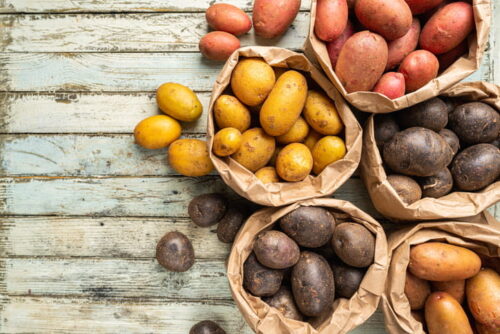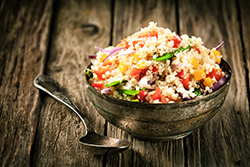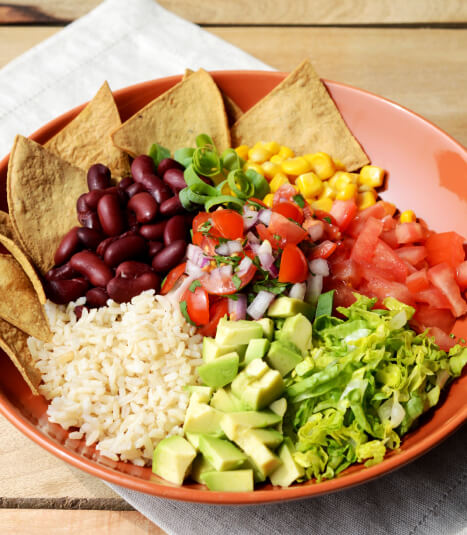Protein, Meat & Poultry
People worry more about protein in their diet than any other nutrient. All plants contain all of the amino acids in proper balance for ideal human growth. In other words, it is impossible to make up a diet deficient in protein or individual amino acids from any unrefined starches (rice, potatoes) and vegetables. You must get over this common myth. The only real problems with protein come from eating too much, usually the result of a diet high in animal foods.
Related Newsletter Articles
+-(articles open in a new window)
- April 2007: When Friends Ask: Where Do You Get Your Protein?
- May 2007: When Friends Ask: “Why Did You Quit Meat?”
- December 2012: Meat and Dairy Make Boys into Men Sooner
- August 2013: GMO Foods: A Potentially Disastrous Distraction
- September 2013: Human Genes are Turned On and Off by Diet
- March 2013: Gluten-free Diets Are Harmful for the General Population (Except for one percent)
- December 2012: Sperm Counts Reduced by Eating Meat and Dairy
- August 2012: The Diet Wars: The Time for Unification Is Now
- May 2011: The Egyptian Mummy Diet Paradox
- January 2010: Five Major Poisons Inherently Found in Animal Foods
- July 2012: Lessons from the Past, Directions for the Future: The WWI Starch Solution for Denmark
- June 2012: The Paleo Diet Is Uncivilized (And Unhealthy and Untrue)
- March 2012: More Death from Meat Eating
- September 2010: What Do Bill Clinton, Steve Wynn, John Mackey, and Mike Tyson Have in Common?
- December 2003: A Brief History of Protein: Passion, Social Bigotry, Rats, and Enlightenment
- January 2004: Protein Overload
- December 2006: An Inconvenient Truth: We Are Eating Our Planet To Death
- November 2011: Why Did Steve Jobs Die?
- December 2006: Global Warming Strategy by Noam Mohr
- June 2007: Confessions of a Fish Killer
- June 2009: Meat Kills People and Planet Earth
- December 2006: Low-carb, High-protein Diets Reduce Survival
- December 2006: Raw Food Vegetarian Diet Protects Us from Cancer
- March 2006: How Foul is Fowl
- March 2005: Eggs Are for Easter
- July 2003: Meat in the Human Diet
- November 2003: The Myth About Meat
- September 2003: Building Your Own High-Performance Athletic Body
- March 2003: Restrict Protein – Save Your Kidneys
- May 2007: Update on “Death by Veganism” by Nina Planck
- June 2007: “Death by Veganism” Begins Its Slow Demise
- June 2007: Save Your Kidneys—Part 1 The Hard Way, with Medications
- November 2008: The First Imaginary Conversation between President-Elect Barack Obama and His Newly Appointed Surgeon General, John McDougall, MD
Related Independent Research
+-Fung TT, Rob M, van Dam RM, Hankinson SE, et al. Low-Carbohydrate Diets and All-Cause and Cause-Specific Mortality: Two Cohort Studies. Annals of Internal Medicine. 2010 Sep; 153(5):289-298. http://annals.org/article.aspx?articleid=746013
Kitagawa T. Increased incidence of non-insulin dependent diabetes mellitus among Japanese schoolchildren correlates with an increased intake of animal protein and fat. Clin Pediatr (Phila). 1998 Feb; 37(2):111-5. http://www.ncbi.nlm.nih.gov/pubmed/9492119
McCarty MF et al., The low-methionine content of vegan diets may make methionine restriction. Med Hypotheses. 2008; doi:10.1016/j.mehy.2008.07.044
http://www.oasisofhope.com/media/pdf/met_vegan.pdf
Ornish D. Holy Cow! What’s Good For You Is Good For Our Planet: Comment on “Red Meat Consumption and Mortality.” Arch Intern Med. 2012 Mar 12. http://bit.ly/145qmA8
Pan A, Sun Q, Bernstein AM, et al. Red Meat Consumption and Mortality: Results From 2 Prospective Cohort Studies. Arch Intern Med. 2012 Mar 12. http://archinte.jamanetwork.com/article.aspx?articleid=1134845
Roughead ZK, Hunt JR, Johnson LK, Badger TM, Lykken GI. Controlled substitution of soy protein for meat protein: effects on calcium retention, bone, and cardiovascular health indices in postmenopausal women. J Clin Endocrinol Metab. 2005 Jan;90(1):1819. http://jcem.endojournals.org/content/90/1/181.full.pdf
Singh PN, Sabaté J, and Fraser GE. Does low meat consumption increase life expectancy in humans? Am J Clin Nutr 2003; 78(suppl):526S–32S. http://ajcn.nutrition.org/content/78/3/526S.full.pdf
Song Y, Manson JE, Buring JE, Liu S. A prospective study of red meat consumption and type 2 diabetes in middle-aged and elderly women: the women’s health study. Diabetes Care. 2004 Sep; 27(9):2108-15. http://care.diabetesjournals.org/content/27/9/2108.full.pdf
Recommended Articles

How to Cook Potatoes

Recipes from the February 2007 Newsletter







